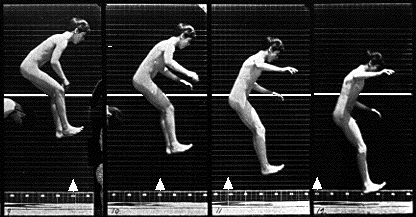
Fashioning the Body: Versions of the Citizen, the Self, and the Subject
The Evergreen State College | Fall 2007-Winter 2008
User Login |
Feminist Video Art of the 1970s - My ResponseOne of the things I observed about the 1970s feminist film selections were that they each provoked a different reaction from me. The first one, by Joan Jonas, was the most difficult for me to watch because it was hard for me to tell what images some of the footage contained. I could see some of the images clearly enough, like the ring on the hand and her bare legs, but others were too blurry for me to decipher. The constant loud banging sounds had an interesting effect on the piece, like they were sort of hammering in the idea that women are constantly being subjected and viewed as objects. I enjoyed the ending of the film, when an androgynous face came into full view and the slides kept vertically flipping past in the background.
The second film, by Lynda Benglis, gave me the same sort of “I-am-imposing-on-someone’s-private-life” feeling that watching Southern Comfort did. The two women kissing were zoomed in on so far that their faces did not fully fit in the frame. Watching the kissing and licking made me feel like I was intruding, and the radio clips made me a little uncomfortable due to their sexist content like, “Go ahead and cry if it will take any weight off you” in regards to some sort of weight loss program. It was interesting when the male radio announcer called one of the female callers “Honey” and the two women just kept rapturously making their private moments so public by filming them. During the Q&A session, Bridget Irish and Colleen Dixon explained that the original screening formats of these films varied, and that it was unlikely to have expected large-scale screenings for some of the pieces. I’m not sure if “Female Sensibility” was one of these, but the fact that it was shown on a large display made me feel like its effectiveness at alienating the audience was intensified.
I was not quite sure what to think of the third piece, “Through the Large Glass,” with the woman slowly stripping off her clothes. She seemed to be mocking so-called feminine behavior by exaggeratedly putting her hand over her mouth when she removed a piece of clothing. There was a lot of head turning and looking to the left and then to the right, lots of tilting her hat and making odd poses as if to make the audience anticipate what she would do next. The second version seemed the same but more blurry and with more close-up shots; the third part, titled “1+2” seemed to just be a combination of scenes from both the first and second versions.
I found the next film, “The East is Red, the West is Bending” to be the most enjoyable of the films screened. It was humorous to listen to a woman with a New York accent reciting from an instructional manual and sarcastically demonstrating the manual’s orders. It was a refreshing twist on the “woman in the kitchen” realm of television that I normally associate with bubbly, fresh-faced females like Rachael Ray.
The final short film, “Technology/ Transformation: Wonder Woman” was highly entertaining. I loved watching the repeated switches of Wonder Woman going from her business casual attire to her tiny, revealing superwoman suit. The disco song with its “Shake your wonder maker” lyric just sort of cemented the entire Wonder Woman character as a ridiculous and stereotypical seductress. I could only laugh and try to think of more positive female role models that are on television today.
Submitted by Ella on Fri, 11/09/2007 - 9:59pm. Ella's blog | login or register to post comments | printer friendly version
|
Who's onlineThere are currently 0 users and 1 guest online.
Events
|
|||||||||||||||||||||||||||||||||||||||||||||||||